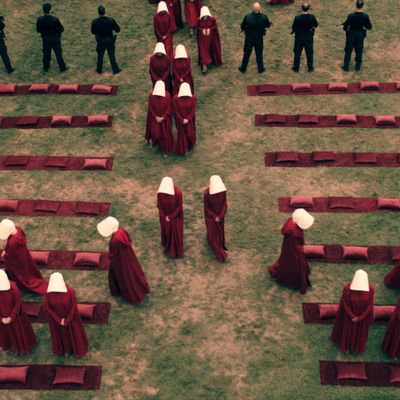
A novel as poignant as Margaret Atwood’s feminist dystopia The Handmaid’s Tale lingers with you. There are feelings that you just can’t shake after reading it: the weight of a heavy wool sleeve on your arm, the tight lips of whispering a secret, the pain in your bones after kneeling for too long. Atwood’s work is filled with subtleties like these that we think can deeply enrich the visual world of Hulu’s new TV adaptation starring Elisabeth Moss. With the series premiering on April 26, here are five memorable details from the book that we hope are captured in the show. Be warned, mild spoilers ahead.
The flowers
Floral imagery is used throughout Atwood’s novel. Delicate beings that bloom into life then wither upon their death are a powerful symbol for the expendability of the handmaid, whose role in society is to reproduce. The ever-present tulips, the backdrop of a blossoming garden, and the oppressive scent of Lily of the Valley perfume are all reminders that a woman’s role is to look pretty, bear the next generation, then quietly disappear. Blessed be the fruit, indeed.
The needlework
Delicate stitches hold many things together in the dystopian world of Gilead. The dainty trim on the wives’ outfits, our protagonist Offred’s (Moss) embroidered pillow, the petals on the canopy bedcover, the servant’s knitting: These are all examples of the maddening busywork society gives women. Their hands need to be occupied so their minds are not.
The high-school details
The handmaids of Gilead learn their new roles at the Red Center, a government education site located in an old school. Memories of adolescence are scattered throughout the place. The shellacked wood floor of the gymnasium, the tiny bathroom stalls — you can just smell the sharp odor of industrial paint in those scenes. The handmaids are being forced into a juvenile state again, so what better place to do that then a den of their childhood?
The magazines
When Offred’s Commander tries to make a bond with her, he offers her small gifts as a pseudo–peace offering. He begins by offering her a relic of femininity: a glossy women’s magazine. Of course, what Offred really wants is a knife, or a noose, but instead she gets a bible of beauty, frivolity, and romance: a man’s idea of what a woman would want.
The epilogue
The novel’s final chapter has come back recently into the public eye, as Atwood herself recorded an extended version of the epilogue for the re-release of the audiobook. The epilogue jumps ahead to a male professor lecturing about Offred and Gilead. It’s a memorable way to end a story about the plight of female characters: a man explaining a woman’s history.


